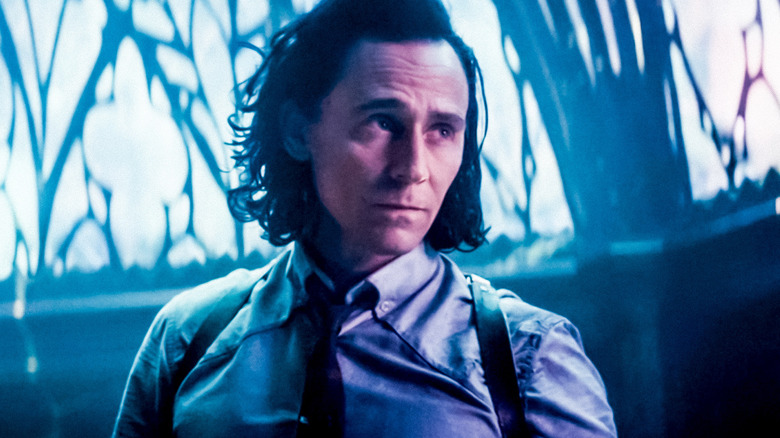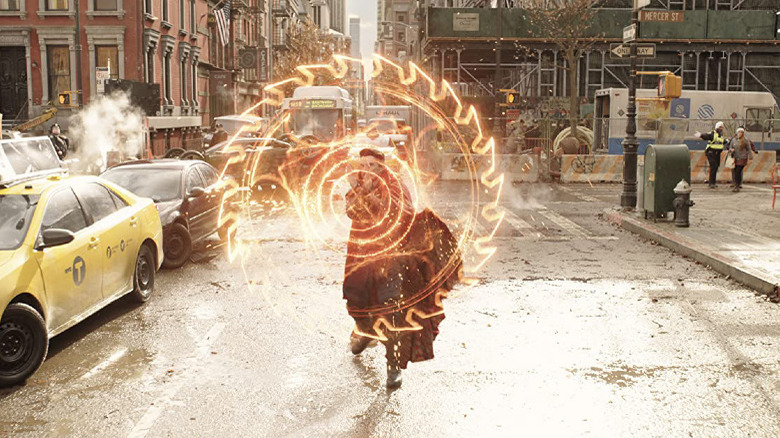The Loki Lesson Michael Waldron Took To Doctor Strange In The Multiverse Of Madness [Exclusive]
There are a lot of moving parts in any Marvel Cinematic Universe movie. From pre-viz and concept art to reshoots and visual effects requiring months of tinkering in post-production, the MCU's films are constantly being changed, both before and well after shooting. It's why it's kind of a miracle when the final product feels like the handiwork of a single guiding vision. Obviously, with the exception of low-budget indie projects where a relatively smaller group of artists come together to make cinematic magic, all movies represent the efforts of hundreds upon hundreds of people collaborating, but that's doubly the case with Marvel Studios' productions.
TV shows used to run counter to that, and some still do — though the rise of streaming has led to massively-inflated budgets on the small screen, with some series matching the cost of an entire low-budget movie for a single episode. Marvel Studios even prides itself on making Disney+ shows that can go toe-to-toe with its films in terms of production values, not least of all when it comes to big, splashy action and spectacle. We saw just that in "Loki" season 1, which went so far as to include a one-take climax wherein Loki (Tom Hiddleston) and Sylvie (Sophia Di Martino) scramble to escape a crumbling city in its third episode.
In a recent interview with /Film, "Loki" season 1 head writer and executive producer Michael Waldron talked about his experience working on the series and how it informed his approach to penning the latest MCU movie, "Doctor Strange in the Multiverse of Madness." When it came to writing the action for the MCU, Waldron came away with a very helpful lesson: you don't. At least, not in any time-consuming amount of detail:
"I think my first drafts of the 'Loki' script, I intimately wrote out every action beat in every fight or action sequence only to see for the most part, a lot of them get thrown out because then they bring on great storyboard artists who are much better at choreographing action than I ever could be. So in this case, I didn't waste a week trying to map out a Doctor Strange battle against a giant octopus. I just kind of hit the big beats and trusted that our amazing artists and stunt teams would really realize those sequences."
Leave the action to the storyboard artists
Prior to running shop on "Loki" season 1, Michael Waldron served as a production assistant and writer on the hit animated series "Rick and Morty," as well as a writers' production assistant and member of the production staff on Dan Harmon's cult comedy show "Community." Having never tackled a project with the scale of the Marvel Cinematic Universe before, Waldron told us he went all-out in his attempts to map the series' action beats. As he quickly realized, however, he was better off leaving this to the storyboard artists who, by now, have spent more than a decade plotting out these kinds of sequences for the MCU.
That's probably a wise move on his part. The MCU's action scenes are so elaborate that it requires a whole lot of time, money, and sweat to see them through to the end. And even then, it's easy for small mistakes like continuity errors to slip by unnoticed, despite having a seasoned veteran in Sam Raimi (director of the original "Spider-Man" trilogy) at the helm on "Multiverse of Madness." Attempting to figure all that out in the writing stage sounds like a nightmare, so it's good to hear Waldron knew better than to even try, and instead stuck to outlining the film's various wizard vs. monster battles in broader strokes.
"Doctor Strange in the Multiverse of Madness" arrives in theaters on May 6, 2022.

